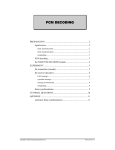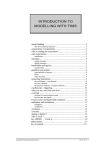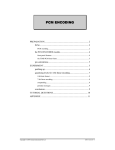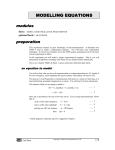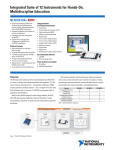Download PCM - DECODING DECODING DECODING
Transcript
PCM - DECODING modules advanced: PCM DECODER, PCM ENCODER preparation The signal to be decoded will be provided by the PCM ENCODER module as set up in the Lab Sheet entitled PCM - encoding which should have already been completed. Also, read about the PCM DECODER module in the TIMS Advanced Modules User Manual. frame synchronization Frame synchronization may be achieved either automatically (embedded information in the received data) or by stealing the FS signal from the transmitter. See page 4. companding This is available, but is not discussed in this Lab Sheet. Read about it ! decoding The PCM DECODER module is driven by an external clock, stolen from, and so synchronized to, that of the transmitter. Upon reception, the PCM DECODER: 1. extracts a frame synchronization signal FS from the data itself (from the embedded alternate ones and zeros in the LSB position), or uses an FS signal stolen from the transmitter (see above). 2. extracts the binary number, which is the coded (and quantized) amplitude of the sample from which it was derived, from the frame. 3. identifies the quantization level which this number represents. 4. generates a voltage proportional to this amplitude level. 5. presents this voltage to the output Vout. The voltage appears at Vout for the duration of the frame under examination. 6. message reconstruction can be achieved, albeit with some distortion, by lowpass filtering. encoding At the encoder the sample-and-hold operation (before encoding) is executed periodically. It produces a rectangular pulse form 1. Each pulse in the waveform is of exactly the same amplitude as the message at the sampling instant. It is not possible to recover a distortionless message from these samples. They are flat top, rather than natural samples. Call this the sampling distortion. At the encoder the amplitude of this waveform was then quantized. It is still a rectangular pulsed waveform, but the amplitude of each pulse will, in general, be in error by a small amount. Call this waveform s(t). 1 if the sample is held for as long as the sampling period, it is a stepped waveform. If the sample is held for a shorter time it is a rectangular waveform (or pulseform). It need only be held long enough for the quantizer to make its decision about which of the available (quantized) amplitudes to allocate to the sample. Copyright © 2005 Emona Instruments Pty Ltd 1/4 Emona-TIMS PCM - decoding L-25 rev 1.3 This is examined in the Lab Sheet entitled Sampling with reference should be made. SAMPLE & HOLD, to which The voltage at Vout of the decoder is identical with s(t) above. The decoder itself has introduced no distortion of the received signal. But s(t) is already an inexact version of the sample-and-hold operation at the encoder. This will give rise to quantization distortion as well as the sampling distortion already mentioned. Read about these phenomena in a Text book. experiment the transmitter (enc (encoder) oder) A suitable source of PCM signal will be generated using a PCM ENCODER module. This module was examined in the Lab Sheet entitled PCM - encoding. 1. 2. 3. 4. 5. 6. 7. PCM ENCODER: on the SYNC MESSAGE switch SW2 set left hand toggle DOWN, right hand toggle UP. This selects a 130 Hz sinusoidal message, which will be used later. use the 8.333 kHz TTL signal from the MASTER SIGNALS module for the CLK. select, with the front panel toggle switch, the 4-bit LINEAR coding scheme. synchronize the oscilloscope to the frame synchronization signal at FS. Set the sweep speed to 0.5 ms/cm (say). This should show a few frames on the screen. connect CH1-A of the SCOPE SELECTOR to the PCM OUTPUT of the PCM ENCODER. we would like to recognise the PCM DATA out signal. So choose a ‘large’ negative DC for the message (from the VARIABLE DC module). The corresponding code word is ‘0000’, so only the embedded alternating ‘0’ and ‘1’ bits (for remote FS) in the LSB position should be seen. They should be 1920 ms apart. Confirm by measurement and calculation ! vary the DC output and show the appearance of new patterns on CH1-A. When finished, return the DC to its maximum negative value (control fully anticlockwise). The PCM signal is now ready for transmission. In a later Lab Sheet the PCM signal will be sent via a noisy, bandlimited channel. For the present it will be connected directly to a TIMS PCM DECODER module. the receiver (decoder) 1. 2. 3. 4. 5. use the front panel toggle switch to match the transmitter encoding scheme ‘steal’ the TTL clock signal and connect it to the CLK input. initially ‘steal’ the frame synchronization signal FS from the transmitter by connecting it to the frame synchronization input FS of the receiver (and check that the FS SELECT toggle switch is set to EXT. FS). ensure both channels of the oscilloscope are set to accept DC; set their gains to 1 volt/cm. With their inputs grounded set their traces in the centre of their respective halves of the screen. Remove the grounds. connect CH2-A to the sample-and-hold output of the PCM DECODER. a DC message Now check the overall transmission from transmitter input to decoder output. The message is a DC signal. 1. TIMS Lab Sheet connect the PCM DATA output signal from the transmitter to the PCM DATA input of the receiver. Copyright © 2005 Emona Instruments Pty Ltd 2/4 Emona-TIMS PCM - decoding L-25 rev 1.3 2. slowly vary the DC output from the VARIABLE DC module back and forth over its complete range. Observe the behaviour of the two traces. The input to the encoder moves continuously. The output from the decoder moves in discrete steps. These are the 16 amplitude quantizing steps of the PCM ENCODER. This is the source of quantizing noise. The output can take up only one of 16 predetermined values. The number of quantizing levels at the transmitter can be checked, and their values. 1. 2. compare the quantizing levels just measured with those determined in the Lab Sheet entitled PCM - encoding. reset the coding scheme on both modules to 7-bit. Sweep the input DC signal over the complete range as before. Notice the ‘granularity’ in the output is almost unnoticeable compared with the 4-bit case. There are now 27 rather than 24 steps over the range. a periodic message It was not possible, when examining the PCM ENCODER in the Lab Sheet entitled PCM encoding, to see the sample-and-hold waveform within the encoder. But, assuming perfect decoding, it is available at the output of the decoder. With a periodic message its appearance may be more familiar. 1. change to a periodic message 2 by connecting the SYNC MESSAGE of the PCM ENCODER, via a BUFFER AMPLIFIER, to its input Vin. An amplitude of 2 Vpp is suitable. Slow down the oscilloscope sweep speed to 1 ms/cm. Observe and record the signal at CH2-A. When you agree that what you see is what you expected to see, prepare to make a change and predict the outcome. Currently the encoding scheme is generating a 4-bit digital word for each sample. What would be the change to the waveform, now displaying on CH2-A, if, at the encoder, the coding scheme was changed from 4-bit to 7-bit ? Sketch your answer to this question - show the waveform before and then after the change. 2. change the coding scheme from 4-bit to 7-bit. That is, change the front panel toggle switch of both the PCM ENCODER and the PCM DECODER from 4-bit to 7-bit. Observe, record, and explain the change to the waveform on CH2-A. message message reconstruction It can be seen, qualitatively, that the output is related to the input. The message could probably be recovered from this waveform. But it would be difficult to predict with what accuracy. Lowpass filtering of the waveform at the output of the decoder will reconstruct the message, although theory shows that it will not be perfect. It will improve with the number of quantizing levels. If any distortion components are present they would most likely include harmonics of the message. If these are to be measurable (visible on the oscilloscope, in the present case), 2 the message should be set up to be a 130 Hz sinewave, synchronized to the sampling rate TIMS Lab Sheet Copyright © 2005 Emona Instruments Pty Ltd 3/4 Emona-TIMS PCM - decoding L-25 rev 1.3 then they must not be removed by the filter and so give a false indication of performance. See the Lab Sheet entitled Amplifier overload. So we could look for harmonics in the output of the filter. But we do not have conveniently available a spectrum analyzer. An alternative is to use a two-tone test message. Changes to its shape (especially its envelope) are an indication of distortion, and are more easily observed (with an oscilloscope) than when a pure sinewave is used. It will be difficult to make one of these here, because our messages have been restricted to rather low frequencies, which are outside the range of most TIMS modules. But there is provided in the PCM ENCODER a message with a shape slightly more complex than a sinewave. It can be selected with the switch SW2 on the encoder circuit board. Set the left hand toggle UP, and the right hand toggle DOWN. See the TIMS Advanced Modules User Manual for more details. A message reconstruction LPF is installed in the PCM DECODER module (version 2 and above). frame synchronization In all of the above work the frame synchronization signal FS has been stolen from the encoder (as has been the clock signal). This was not necessary. The PCM ENCODER has circuitry for doing this automatically. It looks for the alternating ‘0’ and ‘1’ pattern embedded as the LSB of each frame. It is enabled by use of the FS SELECT front panel toggle switch. Currently this is set to EXT FS. 1. change the FS SELECT switch on the front panel of the PCM DECODER module from EXT FS to EMBED. Notice that frame synchronization is re-established after a ‘short time’. Could you put an upper limit on this time ? appendix: automatic frame synchronization The PCM DECODER module has built in circuitry for locating the position of each frame in the serial data stream. The circuitry looks for the embedded and alternating ‘0’ and ‘1’ in the LSB position of each frame. The search is made by examining a section of data whose length is a multiple of eight bits. The length of this section can be changed by the on-board switch SW3. Under noisy conditions it is advantageous to use longer lengths. The switch settings are listed in Table A-1 below. left toggle UP UP DOWN DOWN TIMS Lab Sheet right toggle UP DOWN UP DOWN groups of eight bits 4 8 16 32 Copyright © 2005 Emona Instruments Pty Ltd 4/4





